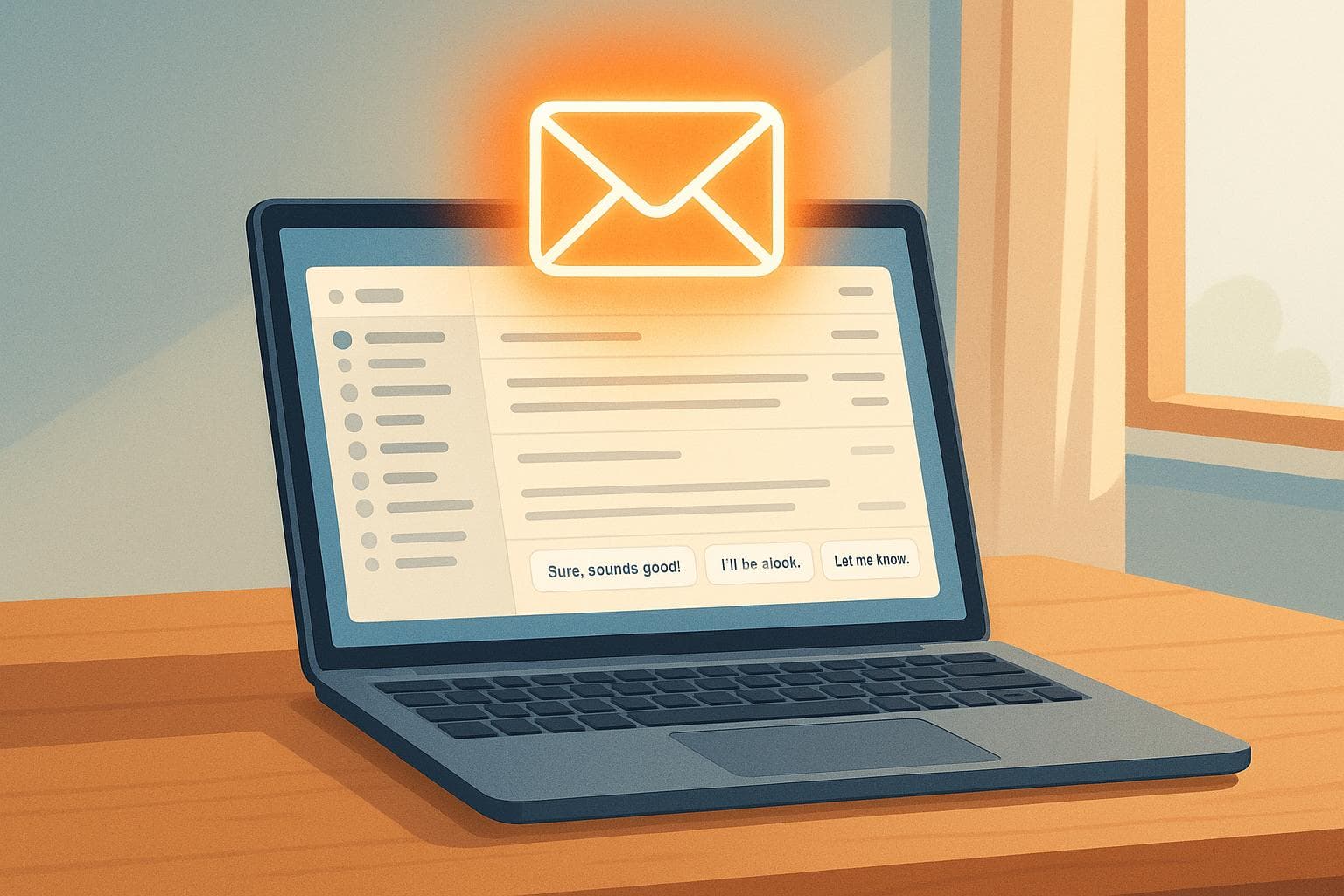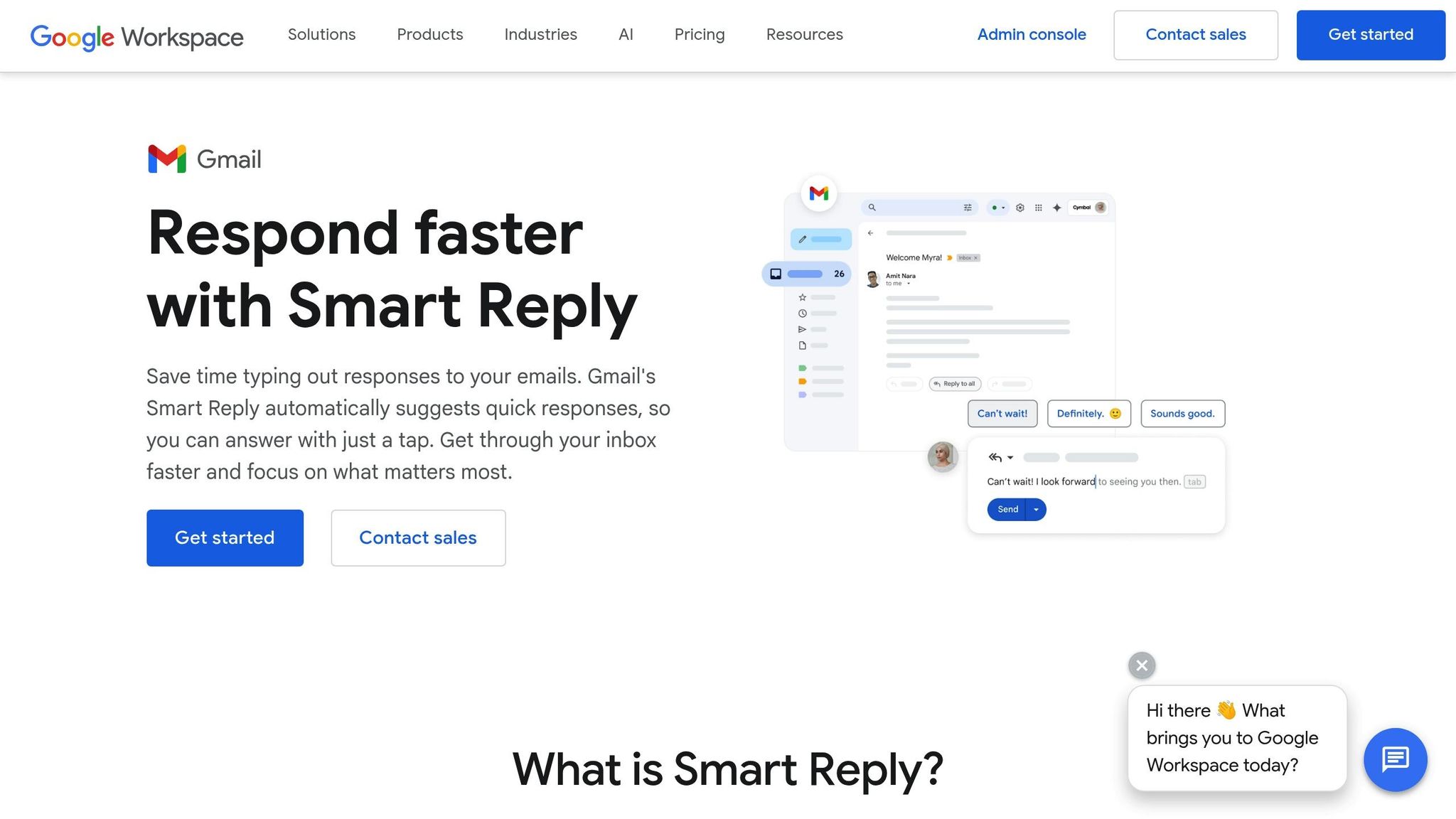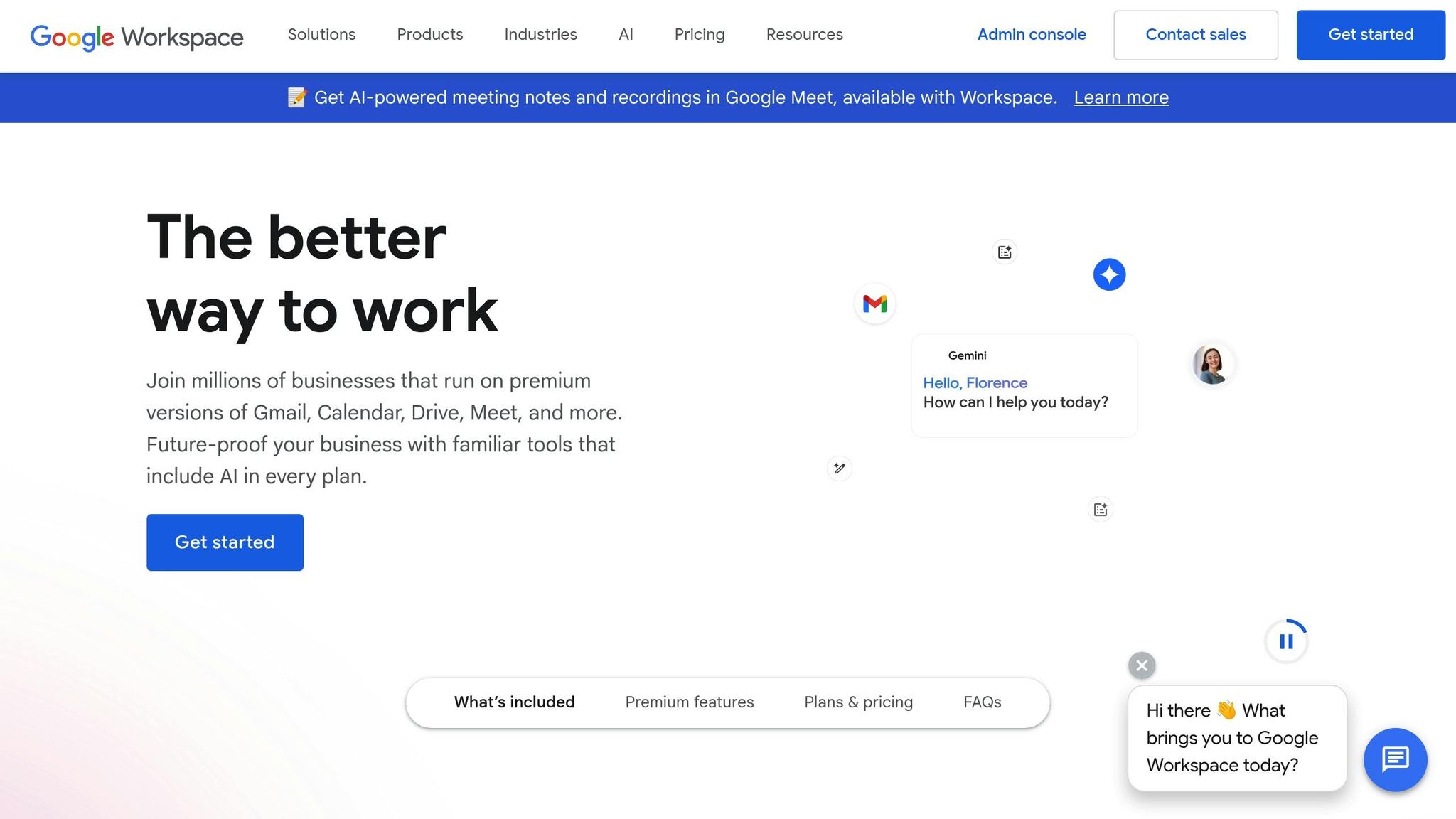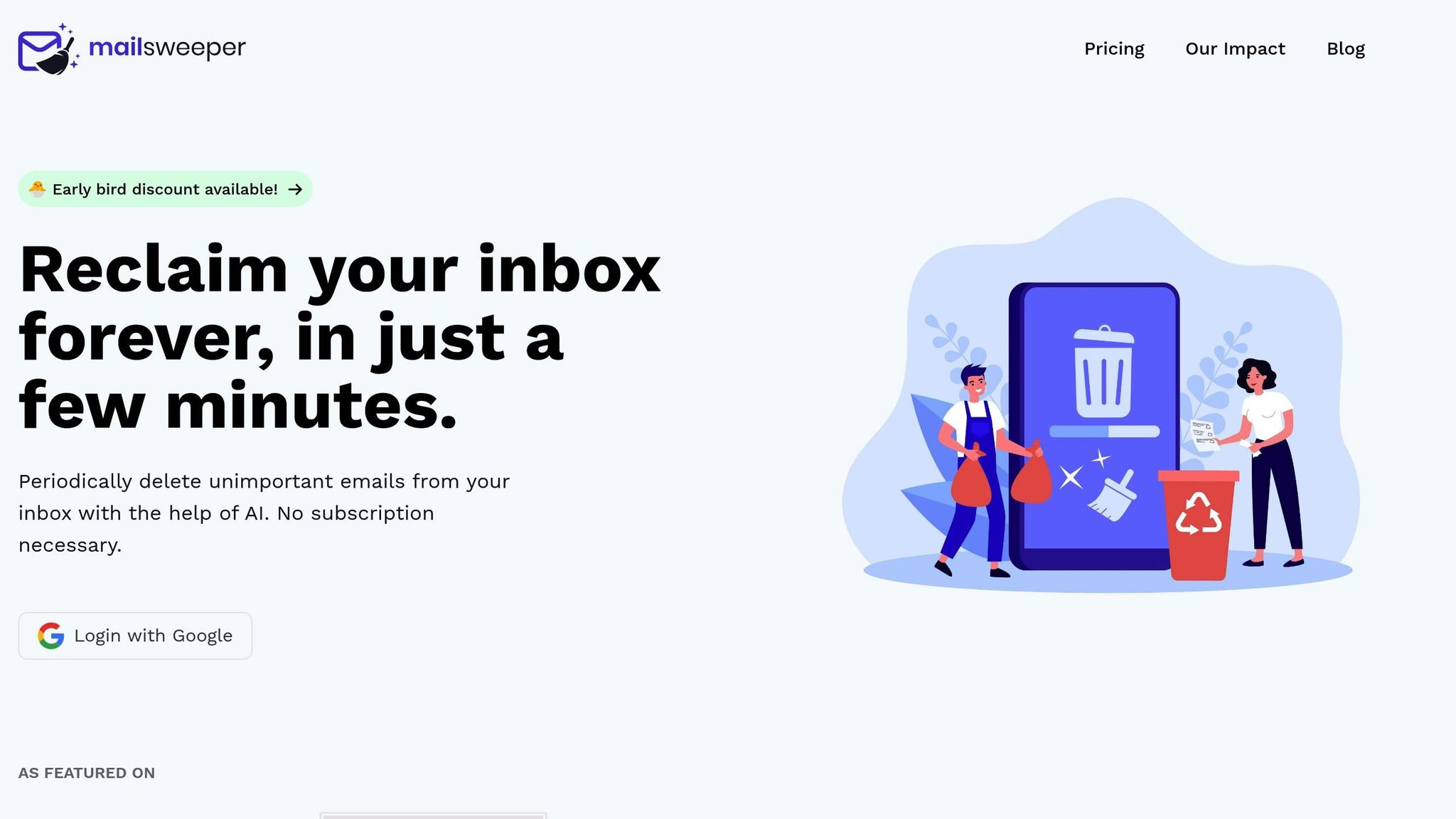Email Management
How to Automate Gmail Replies with AI
Streamline your email workflow with AI tools that automate replies, organize your inbox, and enhance productivity, saving you valuable time.

How to Automate Gmail Replies with AI
Managing your Gmail inbox doesn't have to be a time-consuming chore. AI tools like Smart Reply, Smart Compose, and third-party solutions such as MailSweeper and Zapier can help you save hours every week by automating replies, organizing emails, and reducing clutter. Here's how you can streamline your email workflow:
- Gmail's Built-In Features: Use Smart Reply for quick responses and Smart Compose for drafting longer emails. Enable these under Gmail settings for faster communication.
- Filters and Auto-Replies: Set up Gmail filters to sort and label emails automatically. Combine them with templates for routine responses.
- Third-Party Tools: Tools like MailSweeper clean up your inbox by removing low-priority emails, while Zapier automates multi-step workflows (e.g., sending replies, logging CRM data, and notifying teams).
- Best Practices: Balance automation with manual attention for sensitive or complex emails. Regularly review AI-generated responses to maintain quality.
How to Automate Your Gmail Replies with AI (Easy Tutorial)
How to Use Gmail's Built-In AI Features
Gmail includes several AI-powered tools designed to simplify email management. Here's a guide to activating and using these features effectively.
Turn On Smart Reply and Smart Compose

Smart Reply helps you respond to emails faster by suggesting up to three quick replies based on the content of the message. These suggestions appear at the bottom of an email, and you can select one with a single click.
To enable Smart Reply:
- Open Gmail and click the gear icon in the upper-right corner.
- Select "See all settings."
- Under the "General" tab, scroll to the Smart Reply section.
- Choose "Smart Reply on" and click "Save Changes."
Smart Compose, which is typically enabled by default, assists while you type by offering sentence completions. Suggested text appears in gray as you write, and you can press the Tab key to accept it. While Smart Reply focuses on brief responses, Smart Compose helps with longer, more detailed emails. Be sure to review suggestions to ensure they align with your tone and intent.
Use Google Workspace AI Tools

If you're a Google Workspace subscriber, you can access advanced AI tools that take email writing to the next level. For instance, Gemini provides contextual Smart Reply options tailored for professional communication. Additionally, the "Help me write" feature can create a complete email draft from a short prompt, making it easy to compose detailed messages quickly.
These tools are available across both desktop and mobile versions of Gmail, ensuring seamless email management wherever you are. They’re especially helpful for tackling complex tasks or maintaining a consistent, professional tone in your correspondence. Together, these features enhance productivity and keep your inbox organized.
Set Up Gmail Filters for Automated Email Management
Gmail filters are an excellent way to streamline your inbox by automatically sorting and responding to emails based on rules you define. They take care of repetitive email tasks, freeing up your time for more pressing matters. In fact, a 2023 survey by Tanka AI revealed that users who applied advanced Gmail filters and auto-replies cut down their email management time by 30% per week.
Create Email Filters
Gmail filters give you precise control over your inbox. To create one, start by clicking on Gmail's search bar and selecting "Show search options." Here, you can define criteria such as specific sender addresses, keywords in the subject line, or whether an email includes attachments.
You can even combine multiple conditions. For example, you might filter emails from certain domains (like @newsletter.com) that also contain specific subject keywords. Once your criteria are set, click "Create filter" and decide what Gmail should do with these messages.
Filters can handle multiple tasks at once. For instance:
- Newsletters: Automatically label them as "Newsletter" and skip the inbox.
- Work Emails: Star messages and apply a "Priority" label when the subject includes words like "urgent" or "deadline."
For even more functionality, enable Templates (found under Settings > Advanced). This allows you to attach custom auto-replies to your filters, making it easier to respond to routine inquiries.
Set Up the Vacation Responder
While filters handle day-to-day tasks, the Vacation Responder is your go-to tool for managing email during temporary absences. To activate it, go to Settings > General > Vacation responder. This feature is designed for short-term use and allows you to specify start and end dates.
When setting up your vacation message, include key details like your return date and an alternative contact for urgent issues. For instance:
"Hello, I am currently out of the office from December 15th to December 29th. I’ll respond upon my return. For urgent matters, please reach out to Sarah Johnson at sarah.johnson@company.com."
The Vacation Responder automatically stops sending replies once the end date has passed. Be mindful when setting the start date - if you save your settings with today or an earlier date, it activates immediately.
| Feature | Gmail Filters + Templates | Vacation Responder |
|---|---|---|
| Customization | Highly flexible (criteria, actions) | Limited (one message for all) |
| Use Cases | Ongoing, specific scenarios | Temporary, out-of-office |
| Multiple Actions | Yes (label, archive, forward, etc.) | No (auto-reply only) |
| Setup Complexity | Moderate (requires templates) | Simple |
sbb-itb-34b9fd2
Add Third-Party AI Tools for Advanced Automation
Gmail's built-in automation is helpful, but third-party AI tools take things to the next level. They offer smarter workflows, seamless cross-platform integrations, and better inbox organization.
These tools allow you to create more advanced automations by connecting your email with business applications. They can analyze sentiment, trigger multi-step workflows, and apply advanced filtering to make managing your inbox less of a chore.
Popular AI Integration Tools for Gmail
Two standout platforms for Gmail automation are Zapier and n8n. Both simplify email workflows, but they cater to slightly different needs.
- Zapier uses a straightforward "if-this-then-that" system, known as "Zaps", to automate tasks. For instance, you could set up a Zap that automatically replies to emails from a specific client, logs the interaction in your CRM, and sends a Slack notification to your team - all without lifting a finger. Zapier's user-friendly interface and extensive app library make it accessible, even for those with zero coding experience.
- n8n, on the other hand, provides greater flexibility. Its visual editor supports complex branching logic, making it ideal for handling more intricate business scenarios. Developers and tech-savvy users often prefer n8n for its customizability and open-source nature.
Both tools can save a significant amount of time - some users report cutting manual email handling by up to 50%. This means less time spent on repetitive tasks like responding to customer inquiries and more time for meaningful work.
While Zapier and n8n excel at multi-step workflows, there are other tools designed to improve inbox organization.
Use MailSweeper for Inbox Organization

If your inbox feels overwhelming, MailSweeper might be the solution. This AI-powered tool specializes in decluttering your inbox by identifying and removing unimportant emails.
MailSweeper works by analyzing your email habits and moving low-priority messages - like promotional emails and newsletters - into a "Dustpan" label. From there, it periodically deletes them. To date, MailSweeper has processed over 2.7 million emails and freed up 195 GB of storage space.
This tool ensures that only relevant emails are left for your automated workflows to handle. For example, it prevents auto-replies from being triggered by spam or trivial messages. Better yet, MailSweeper doesn’t touch starred or primary inbox messages, and you can customize which types of emails it sweeps.
Available for a one-time payment starting at $16, MailSweeper can also help businesses save on Google Workspace storage costs, which start at $6 per user per month for 30 GB.
| Tool | Primary Function | Integration Depth | Pricing Model | Best For |
|---|---|---|---|---|
| Zapier | Workflow automation | 3,000+ apps | Subscription ($19.99/month+) | Broad business integrations |
| n8n | Custom workflows | Highly flexible | Free/Paid Cloud | Technical users, developers |
| MailSweeper | AI-powered inbox cleaning | Gmail-focused | One-time (from $16) | Inbox organization and storage optimization |
To get started, identify the email tasks that eat up the most time and focus on automating those first. Many users find success by combining tools - using MailSweeper to clean up their inbox while relying on Zapier or n8n for automating responses and integrating with other business apps.
Best Practices for AI Email Automation
Getting AI email automation up and running is just the beginning; using it wisely is where the real value lies. By fine-tuning these tools, you can simplify repetitive tasks while maintaining professionalism in your communications. The tips below build on Gmail's built-in features and third-party tools discussed earlier.
Balance Automation with Personal Touch
Not every email is suited for automation. Routine tasks like scheduling confirmations, basic customer service responses, and acknowledgment emails are ideal for AI. But for sensitive issues, complex discussions, or relationship-building, a personal response is non-negotiable.
For instance, Smart Reply can cut response times for routine emails by up to 50%. Experts in email productivity recommend leveraging AI for repetitive tasks but keeping a human hand on the wheel for more nuanced communications. To ensure automated messages still feel personal, review and tweak AI-generated drafts before hitting send. Avoid generic templates; instead, make adjustments to reflect the recipient's unique context.
To avoid missteps, establish clear rules about what can and can’t be automated. For example, emails from key clients, complaints, or first-time inquiries should always be handled manually. Gmail’s filters can help redirect these critical messages away from automated workflows. Remember, the goal is for automation to complement your communication style, not replace it.
Once you've added a personal touch to your automation, test the responses to make sure they align with your expectations.
Test and Monitor AI Responses
After setting up your automation rules, start small by testing AI responses on sample emails. Look closely at how the replies handle tone, accuracy, and relevance - especially for customer-facing or high-volume accounts.
Make it a habit to review your "Sent" folder regularly to catch and correct errors. Gmail’s thumbs up or thumbs down feedback on Smart Reply suggestions is a handy way to teach the AI your preferences and improve future responses. Pay attention to recipient reactions too; if automated messages lead to confusion or frustration, it’s time to tweak your setup.
Keep track of common failures in automation. For example, an AI might send a meeting confirmation without considering time zones or miss emotional cues in a customer’s complaint. These patterns can help you refine your rules and identify situations where manual intervention is essential.
To stay organized, tools like MailSweeper can help keep your inbox tidy, ensuring critical emails don’t get lost in the shuffle of automated replies. A clutter-free inbox allows you to focus on the messages that need your direct attention while leaving routine tasks to AI.
The aim isn’t to achieve flawless automation - it’s to create a system that saves time without sacrificing the quality of your professional relationships. Smart automation strikes the perfect balance.
Conclusion: Improve Your Email Workflow with AI
Using AI to automate Gmail replies can transform how you handle email communication. By combining Gmail's built-in tools like Smart Reply and Smart Compose with third-party integrations and specialized tools such as MailSweeper, you create an email management system that operates seamlessly. Google reports that features like Smart Reply and Smart Compose help users cut email management time by 20–30%. Add MailSweeper into the mix - having processed over 2.7 million emails and saved 195 GB of storage space - and the efficiency gains become even more impressive.
This multi-layered strategy tackles every aspect of email management. Gmail’s AI tools handle quick replies and assist with drafting, while advanced filters and external tools automate more complex workflows and custom responses. MailSweeper further enhances this system by automatically identifying and removing unnecessary emails, keeping your inbox organized and ensuring critical messages aren't buried under clutter. Together, these tools not only streamline your workflow but also help reduce operational costs.
The financial benefits are hard to ignore. MailSweeper’s affordable, one-time payment model - starting at just $16 for lifetime access - eliminates recurring subscription fees. It also helps you stay within Gmail’s free storage limits, saving you from purchasing additional space while ensuring your automated responses target the emails that truly matter. The result? You save hours each week while maintaining a high standard of professionalism in your email communication.
Start with Gmail’s native AI tools, apply tailored filters, and let MailSweeper keep your inbox clean. This combination creates a self-sustaining email management system that aligns with your communication habits and minimizes manual effort.
Managing your inbox doesn’t have to feel like an endless chore. With the right mix of AI-driven tools, you can reclaim valuable time each week while ensuring important emails get the attention they deserve. By addressing email clutter head-on, this approach delivers the promise of an efficient, stress-free inbox.
FAQs
How can I make sure AI-generated email replies sound like me?
To make AI-generated email replies sound more like you, start by tweaking the settings in your AI tool. Many platforms let you choose a tone - whether it's formal, casual, or friendly. You can also help the AI learn your style by sharing examples of your past emails or fine-tuning its suggestions to better align with how you typically write.
Feeling buried under a mountain of emails? Tools like MailSweeper can take some of the pressure off by automatically sorting out less important messages. This not only saves you time but also keeps your inbox more organized.
How can I effectively combine automated and manual email management?
To find the sweet spot between automated and manual email management, let AI tools take care of repetitive tasks - like sorting emails or replying to standard queries - while you focus on handling messages that need a personal touch. Make it a habit to review automated responses to ensure they reflect your tone and intentions.
For example, tools like MailSweeper can automatically clear out unimportant emails, keeping your inbox tidy so you can concentrate on what really matters. This approach not only saves time but also helps you stay professional and precise in your communications.
How can MailSweeper help automate and organize my Gmail inbox?
MailSweeper connects effortlessly with Gmail to make managing your emails a breeze. Once you log in with your Google account and complete a single purchase, you can tailor your inbox settings to match your preferences. From there, MailSweeper takes over, quietly working in the background to identify and clean out unnecessary emails. This not only helps cut down on storage costs but also keeps your inbox organized and free of clutter. The best part? It all happens automatically, saving you time and effort.
